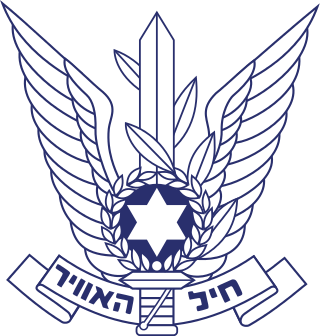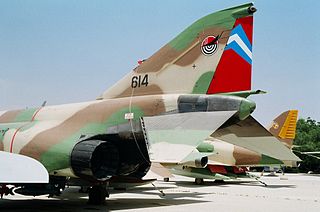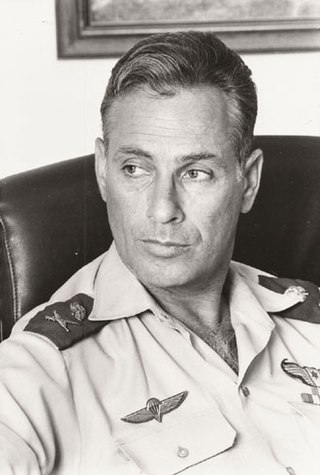
The Israeli Air Force operates as the aerial warfare branch of the Israel Defense Forces (IDF). It was founded on May 28, 1948, shortly after the Israeli Declaration of Independence. As of April 2022, Aluf Tomer Bar has been serving as the Air Force commander.

The War of Attrition involved fighting between Israel and Egypt, Jordan, the Palestine Liberation Organisation (PLO) and their allies from 1967 to 1970.

The Egyptian Air Force (EAF) (Arabic: القوات الجوية المصرية, romanized: El Qūwāt El Gawīyä El Maṣrīya), is the aviation branch of the Egyptian Armed Forces that is responsible for all airborne defence missions and operates all military aircraft, including those used in support of the Egyptian Army, Egyptian Navy and the Egyptian Air Defense Forces. The latter was created as a separate command in the 1970s and it coordinates with the Air Force to integrate air and ground-based air defense operations. The EAF is headed by an air marshal (lieutenant general equivalent). Currently, the commander of the Egyptian Air Force is Air Marshal Mahmoud Fouad Abdel-Gawad. The force's motto is 'Higher and higher for the sake of glory' (Arabic: إلى العلا في سبيل المجد, I‘la’ al-'olà fī sabīl al-magd). It was known as the Royal Egyptian Air Force until 18 June 1953 following the declaration of the Republic of Egypt by Muhammad Naguib.

The Douglas A-4 Skyhawk is a single-seat subsonic carrier-capable light attack aircraft designed and produced by the American aerospace manufacturer Douglas Aircraft Company, and later, McDonnell Douglas. It was originally designated A4D under the United States Navy's pre-1962 designation system.

Operation Focus was the opening airstrike by Israel at the start of the Six-Day War in 1967. It is sometimes referred to as the "Sinai Air Strike". At 07:45 on 5 June 1967, the Israeli Air Force (IAF) under Maj. Gen. Mordechai Hod launched a massive airstrike that destroyed the majority of the Egyptian Air Force on the ground. Following Syrian and Jordanian attacks in retaliation, the Israeli Air Force proceeded to bomb air bases in those countries. By noon, the Egyptian, Jordanian and Syrian Air Forces, totaling about 450 aircraft, were destroyed. It was also very successful in disabling 18 airfields in Egypt, hindering Egyptian air operations for the duration of the war, and remains one of the most successful air attack campaigns in military history.

The 69 "Hammers" Squadron is an Israeli Air Force squadron operating the F-15I Thunder out of Hatzerim. It was formed in July 1948 to operate three B-17 Flying Fortresses which the fledgling Israeli Air Force had acquired in the United States. The squadron flew the Flying Fortress, an aircraft credited with propelling the IAF into the realm of modern aerial warfare, during both the 1948 Arab–Israeli War and 1956 Suez Crisis. Disbanded in early 1957, 69 Squadron reformed in 1969 to fly the F-4 Phantom II.

Avraham "Avi" Lanir was a lieutenant colonel in the Israel Air Force. He was the highest-ranking Israeli fighter pilot to fall into enemy hands.
The air battle of Mansoura was an air battle that took place during the Yom Kippur War between the Egyptian Air Force (EAF) and the Israeli Air Force (IAF) near the town of El Mansoura, in the Nile Delta.

The Priha (Blossom) Operations were a series of strikes undertaken by the Israeli Air Force during the War of Attrition. Taking place between January and April 1970, the operations consisted of 118 sorties against targets in the Egyptian heartland. The strikes were carried out almost exclusively by the F-4 Phantom II, operated at the time only by the 201 "The One" Squadron and the 69 "Hammers" Squadron. Although tactically successful, the operations failed to achieve their objective of pushing the Egyptian government to sue for a ceasefire.
Bir Gifgafa is an airfield in the Sinai, 90 km east of the Suez Canal. During the 1960s and 1970s it played a significant role in Arab–Israeli wars, at different times serving both Egypt and Israel.
Rimon 20 was the code name of an aerial battle in 1970 which pitted the Israeli Air Force directly against Soviet fighter pilots stationed in Egypt during the War of Attrition. Israel planned the dogfight in order to send a message that it would no longer tolerate direct Soviet military involvement in its conflict with Egypt.

Avihu Ben-Nun was the 11th commander of the Israeli Air Force between 1987 and 1992.

Operation Raviv, also known in Egypt as the Zaafarana accident or the Ten-Hour War, was a mounted raid conducted by the Israeli Defence Forces (IDF) on Egypt's Red Sea coast during the War of Attrition. Taking place on September 9, 1969, Raviv was the sole major ground offensive undertaken by the IDF against Egypt throughout the war. The operation saw Israeli forces masquerading as Egyptian troops and using captured Arab armor.

115 Squadron, also known as the Flying Dragon or Red Squadron, is the Israeli Air Force's aggressor squadron. Based at Ovda, it is the sole IAF squadron to operate fixed-wing aircraft, helicopters and ground-based assets.

Giora Romm was an Israeli military officer who served as deputy commander of the Israeli Air Force (IAF), Israel's military attaché in the United States and as director of the Civil Aviation Authority of Israel. Romm was the IAF's first jet ace, scoring five kills during the 1967 Six-Day War. In 1969, during the War of Attrition, Romm was shot down and spent several months in Egyptian captivity. He commanded the IAF's 115 Squadron through the intensive fighting of the 1973 Yom Kippur War and participated in Operation Wooden Leg, the 1985 raid against PLO headquarters in Tunisia.

Amir Nachumi is a retired Israeli Air Force Brigadier General who, in the course of his career, shot down 14 enemy aircraft, making him one of Israel's top flying aces. He scored 7 aerial kills in the F-4 Phantom II during the Yom Kippur War, 7 in the F-16 Fighting Falcon in fighting over Lebanon, and participated in Operation Opera, the 1981 raid that destroyed an Iraqi nuclear reactor.

147 Squadron, often referred to as the Flying Ibex or Goring Ram squadron, is a former unit of the Israeli Air Force. Fielding IAF Flight Academy aircraft, it flew the Boeing-Stearman Kaydet during the 1956 Suez Crisis and the Fouga Magister during the 1967 Six-Day War, in the course of which it suffered six fatalities. Between 1978 and 1986 it flew the A-4 Skyhawk.

The History of the Israel Air Force begins in May 1948, shortly after the formation of the State of Israel. Following Israel's declaration of independence on May 14, its pre-state national institutions transformed into the agencies of a state, and on May 26, 1948, the Israeli Air Force was formed. Beginning with a small collection of light aircraft, the force soon transformed into a comprehensive fighting force. It has since participated in several wars and numerous engagements, becoming what has been described as "The mightiest air force in the Middle East".

Ran Goren is a retired fighter pilot and Major General of the IDF, former Deputy Commander of the Air Force and Head of the Manpower Directorate.

Rami Harpaz was a colonel in the Israel Defence Forces and a prisoner of war during the War of Attrition. Harpaz served as a fighter pilot in the Israeli Air Force (IAF) and spent three and a half years in an Egyptian prison. Following his release, he returned to the Air Force, and came to command the IAF base at Ramat David.


















